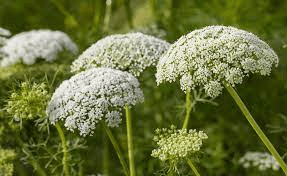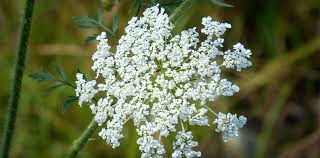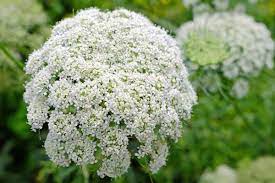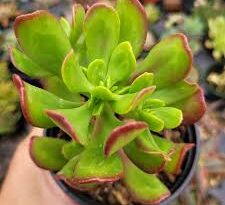10 Medicinal Health Benefits Of Queen Anne’s Lace (Daucus carota)
Queen Anne’s Lace, scientifically known as Daucus carota, is a biennial plant that belongs to the Apiaceae family. Also commonly referred to as wild carrot, this herbaceous species is native to Europe and southwest Asia but has naturalized in many parts of North America. Queen Anne’s Lace is known for its distinctive flat-topped clusters of tiny, white flowers and its characteristic carrot-like root.
The plant typically grows in fields, meadows, and along roadsides, reaching heights of 1 to 3 feet. The lacy, fern-like leaves are arranged in a basal rosette during the first year of growth, while the flowering stem emerges in the second year. The flowers, which form dense umbels, consist of numerous small white florets with a single dark purple or red flower at the center. This central flower is often referred to as the “Queen Anne” or the “bird’s nest.”
One notable feature of Queen Anne’s Lace is its edible taproot, which closely resembles that of the domestic carrot (Daucus carota subsp. sativus). However, caution is necessary when foraging for wild carrots, as there is a look-alike plant known as poison hemlock (Conium maculatum), which is highly toxic. Proper identification, including examination of the stem and smell (carrot-like fragrance), is crucial for safe foraging.
In addition to its historical use as a food source, Queen Anne’s Lace has been utilized in traditional medicine. Some herbalists have explored the potential medicinal properties of the plant, considering it for its diuretic and digestive properties. However, it’s important to note that caution should be exercised, and expert guidance sought, before using wild plants for medicinal purposes.
Queen Anne’s Lace is appreciated for its aesthetic value, adding a delicate and ethereal quality to natural landscapes. However, it’s important to be aware that this plant can be invasive in some regions, competing with native vegetation.
Culturally, Queen Anne’s Lace has inspired folklore and legends. One common tale suggests that the dark central flower represents a drop of Queen Anne’s blood, pricked while making lace. This whimsical story adds to the charm and intrigue associated with this wildflower.
Whether admired for its intricate flowers, culinary potential, or historical significance, Queen Anne’s Lace remains a fascinating and multifaceted plant, embodying both beauty and practicality in the diverse ecosystems it inhabits.
The Botanical Description of Queen Anne’s Lace (Daucus carota)
1. Plant Morphology: Queen Anne’s Lace, scientifically known as Daucus carota, is a biennial plant belonging to the Apiaceae family. In its first year, it forms a rosette of finely divided leaves close to the ground. During the second year, it produces a tall, branched stem, reaching heights of up to three feet.
2. Leaves: The leaves of Queen Anne’s Lace are pinnately compound, characterized by fern-like divisions. Each leaflet is finely dissected, giving the plant an airy and delicate appearance. The rosette leaves are more basal, while the stem leaves are alternately arranged.
3. Flowers: The plant is renowned for its umbrella-shaped flower clusters known as umbels. The compound umbels consist of numerous small, white flowers, with a single dark purple to black floret at the center. The arrangement resembles lace, hence the common name.
4. Inflorescence: The inflorescence of Queen Anne’s Lace is flat-topped and measures several inches in diameter. The compound umbels create a visually striking and intricate pattern, adding to the plant’s allure.
5. Root: The root of Queen Anne’s Lace is a prominent taproot, which is edible and has a carrot-like appearance. However, caution should be exercised when foraging for wild carrots, as misidentification can lead to consuming toxic plants.
6. Stem: The stem of Queen Anne’s Lace is erect, hollow, and furrowed. It bears fine hairs, contributing to the plant’s overall texture. The stem branches into several rays, each supporting an umbel of flowers.
7. Fruits: After flowering, Queen Anne’s Lace produces distinctive fruits known as schizocarps. These dry fruits split into two mericarps, each containing a seed. The mericarps bear small bristles that aid in their dispersal by attaching to passing animals or clothing.
8. Floral Fragrance: The flowers of Queen Anne’s Lace emit a mild, sweet fragrance. The scent attracts pollinators, including bees, butterflies, and other beneficial insects.
9. Blooming Period: Queen Anne’s Lace typically blooms from late spring to early fall, depending on the geographical location. The flowering period contributes to its ecological role as a nectar source for pollinators.
10. Ecological Adaptations: As a biennial plant, Queen Anne’s Lace has specific ecological adaptations. Its ability to produce a rosette in the first year helps it conserve energy, while the tall flowering stem in the second year maximizes reproductive success through increased visibility to pollinators.
The Geographic Distribution of Queen Anne’s Lace (Daucus carota)

1. Native Range: Queen Anne’s Lace is native to Europe and southwestern Asia. It has a longstanding history in these regions, where it has adapted to various environmental conditions.
2. Naturalized Regions: Over the centuries, Queen Anne’s Lace has become naturalized in many parts of North America, Australia, and New Zealand. The plant thrives in temperate climates with well-drained soil.
3. Preferred Habitats: This adaptable plant can be found in a variety of habitats, including fields, meadows, roadsides, and disturbed areas. It tends to flourish in areas with ample sunlight.
4. Invasive Potential: While Queen Anne’s Lace is appreciated for its aesthetic qualities, it has the potential to become invasive in certain regions. Its prolific seed production and effective dispersal mechanisms contribute to its ability to colonize new areas.
5. Altitudinal Range: Queen Anne’s Lace can be found at varying altitudes, from lowland areas to mountainous regions. Its ability to thrive in diverse elevations showcases its ecological versatility.
6. Climate Tolerance: The plant exhibits tolerance to a range of climates, including temperate, Mediterranean, and subtropical. Its adaptability to different climate zones contributes to its widespread distribution.
7. Soil Preferences: Queen Anne’s Lace is not overly particular about soil type but prefers well-drained soils. It can tolerate a range of soil textures, from sandy to loamy, making it resilient in different environments.
8. Human-Mediated Spread: Human activities, such as agriculture and transportation, have played a role in the plant’s global spread. Queen Anne’s Lace often establishes itself in disturbed areas, showcasing its ability to colonize human-altered landscapes.
9. Ecological Interactions: In its introduced regions, Queen Anne’s Lace interacts with local ecosystems. It provides nectar for pollinators and serves as a host plant for certain butterfly species, contributing to local biodiversity.
10. Conservation Concerns: While valued for its beauty and ecological contributions, Queen Anne’s Lace can pose challenges in conservation areas. The plant’s competitive nature may outcompete native vegetation, leading to management considerations in some regions.
The Chemical Composition Of Queen Anne’s Lace (Daucus carota)
1. Carotenoids: Queen Anne’s Lace is rich in carotenoids, including beta-carotene, which gives the plant’s taproot its characteristic orange color. Carotenoids are antioxidants that play a role in human health.
2. Flavonoids: Flavonoids are compounds found in Queen Anne’s Lace with potential antioxidant and anti-inflammatory properties. These phytochemicals contribute to the overall health benefits associated with the plant.
3. Essential Oils: The plant contains essential oils, contributing to its aromatic properties. These oils may have antimicrobial properties and play a role in the plant’s defense mechanisms.
4. Polyacetylenes: Polyacetylenes are compounds found in Queen Anne’s Lace that may have anti-inflammatory and antibacterial properties. These bioactive compounds contribute to the plant’s medicinal potential.
5. Coumarins: Coumarins are another group of compounds present in Queen Anne’s Lace. These compounds may have anticoagulant properties and contribute to the plant’s overall chemical diversity.
6. Phenolic Compounds: Phenolic compounds, including phenolic acids, are found in Queen Anne’s Lace and contribute to its antioxidant capacity. These compounds have implications for human health.
7. Vitamins and Minerals: Queen Anne’s Lace is a source of various vitamins and minerals, including vitamin A, vitamin K, and minerals like potassium. These nutrients play essential roles in human health and well-being.
8. Dietary Fiber: The plant contains dietary fiber, which is beneficial for digestive health. Fiber contributes to regular bowel movements and can aid in maintaining a healthy digestive system.
9. Antioxidant Capacity: Queen Anne’s Lace exhibits antioxidant activity due to its rich content of carotenoids, flavonoids, and other compounds. Antioxidants help neutralize free radicals in the body, contributing to overall health.
10. Phytochemical Diversity: The chemical composition of Queen Anne’s Lace showcases a diverse array of phytochemicals. This chemical diversity contributes to the plant’s versatility, both in traditional medicinal uses and potential
Read Also: 8 Medicinal Health Benefits Of Lavender (Lavandula angustifolia)
The Medicinal Health Benefits Of Queen Anne’s Lace (Daucus carota)

1. Digestive Health: Queen Anne’s Lace has been traditionally used to support digestive health. The plant may aid in alleviating digestive discomfort, promoting regular bowel movements, and addressing minor gastrointestinal issues.
2. Anti-Inflammatory Properties: The presence of bioactive compounds in Queen Anne’s Lace contributes to its anti-inflammatory properties. These properties may assist in reducing inflammation and associated symptoms in various parts of the body.
3. Respiratory Support: Some herbal traditions suggest that Queen Anne’s Lace may offer respiratory support. It is believed to have potential benefits for conditions affecting the respiratory system, such as coughs or mild respiratory congestion.
4. Skin Soothing Effects: Topical applications of Queen Anne’s Lace may provide skin-soothing effects. The plant’s essential oils and compounds could contribute to addressing skin irritations, insect bites, or minor wounds.
5. Diuretic Effects: Queen Anne’s Lace has diuretic properties that may contribute to increased urine production. This diuretic effect is believed to support kidney function and may aid in detoxification processes.
6. Menstrual Comfort: Traditional uses include Queen Anne’s Lace for addressing menstrual discomfort. The plant is thought to have mild antispasmodic properties, potentially easing menstrual cramps.
7. Antioxidant Support: The plant’s antioxidant properties may offer support against oxidative stress. Antioxidants help neutralize free radicals, contributing to overall cellular health.
8. Relaxant and Calming Effects: Some herbal practices attribute relaxant and calming effects to Queen Anne’s Lace. These properties may help individuals manage stress and promote a sense of relaxation.
9. Potential Antimicrobial Activity: Preliminary studies suggest that Queen Anne’s Lace may exhibit antimicrobial activity. This could imply a role in combating certain bacteria or fungi, contributing to overall immune support.
10. Urinary Tract Health: Queen Anne’s Lace has been traditionally associated with urinary tract health. Its diuretic properties may contribute to maintaining a healthy urinary system.
The Methods of Usage to Achieve the Provided Health Benefits Of Queen Anne’s Lace (Daucus carota)
1. Herbal Infusions: Prepare herbal infusions by steeping dried Queen Anne’s Lace leaves or flowers in hot water. This method is suitable for extracting the plant’s beneficial compounds for digestive and respiratory support.
2. Topical Applications: Create salves or poultices using Queen Anne’s Lace for topical applications. Apply these preparations to the skin to harness the plant’s skin-soothing effects for addressing minor skin issues.
3. Tinctures: Tinctures involve extracting the plant’s compounds using alcohol or glycerin. This method provides a concentrated liquid form, making it convenient for those seeking the medicinal benefits of Queen Anne’s Lace.
4. Culinary Uses: Incorporate young Queen Anne’s Lace roots into culinary creations. The roots are edible and can be added to salads or cooked dishes, offering a potential way to enjoy the plant’s benefits.
5. Herbal Teas: Brew herbal teas using Queen Anne’s Lace leaves, flowers, or roots. This method is suitable for individuals seeking a mild and soothing way to experience the plant’s health benefits.
6. Steam Inhalation: Inhale steam infused with Queen Anne’s Lace to potentially benefit respiratory health. This method may offer relief for individuals dealing with respiratory discomfort.
7. Capsules or Supplements: For those preferring a more convenient option, Queen Anne’s Lace extracts are available in capsule or supplement form. This allows users to easily incorporate the plant into their wellness routine.
8. Bath Additions: Add Queen Anne’s Lace to baths for a relaxing experience. This method may provide a gentle way to enjoy the plant’s calming effects and potential benefits for the skin.
9. Compresses: Create compresses using Queen Anne’s Lace preparations for localized application. This method is suitable for addressing specific areas of discomfort or irritation.
10. Consultation with Herbal Practitioners: Before incorporating Queen Anne’s Lace into a health regimen, especially for medicinal purposes, it is advisable to consult with herbal practitioners or healthcare professionals. They can provide personalized guidance on usage methods and dosage.
The Side Effects Of Using Queen Anne’s Lace Medicinal Plant
1. Allergic Reactions: Some individuals may experience allergic reactions to Queen Anne’s Lace. It is advisable to perform a patch test before topical use and seek medical attention if any adverse reactions occur.
2. Photosensitivity: Topical applications of Queen Anne’s Lace may increase sensitivity to sunlight. Users should avoid prolonged sun exposure after applying preparations to prevent photosensitivity reactions.
3. Gastrointestinal Discomfort: In some cases, excessive consumption of Queen Anne’s Lace may lead to gastrointestinal discomfort. Adhering to recommended dosage guidelines is crucial to avoid adverse effects.
4. Pregnancy and Lactation: Pregnant and breastfeeding individuals should exercise caution when considering the use of Queen Anne’s Lace. Limited research exists on its safety during pregnancy and lactation.
5. Medication Interactions: Queen Anne’s Lace may interact with certain medications, particularly those affecting blood clotting or the central nervous system. Individuals on prescribed medications should seek professional advice before using the plant medicinally.
6. Not Suitable for Children: The medicinal use of Queen Anne’s Lace may not be suitable for children. Consultation with healthcare professionals is advisable for this demographic.
7. Respiratory Sensitivity: Individuals with respiratory sensitivity or asthma should use caution when inhaling steam infused with Queen Anne’s Lace to avoid potential respiratory irritation.
8. Not a Substitute for Professional Medical Advice: Queen Anne’s Lace-based remedies should not replace professional medical advice, diagnosis, or treatment. Individuals with health concerns or chronic conditions should consult healthcare providers for personalized guidance.
9. Monitoring for Adverse Reactions: Users should monitor for any adverse reactions, including allergic responses, gastrointestinal discomfort, or skin irritation. Discontinuing use and seeking medical attention if adverse reactions occur is advisable.
10. Storage and Handling: Proper storage and handling of Queen Anne’s Lace preparations are essential. Store them in a cool, dry place away from direct sunlight. Follow recommended storage practices to maintain potency and safety.
Read Also: How to Grow, Use and Care for Woolly Sedge Grass (Carex pellita)
The Scientific Research and Studies of Queen Anne’s Lace (Daucus carota)

1. Phytochemical Analysis: Scientific research on Queen Anne’s Lace has delved into its phytochemical composition. Studies have identified various bioactive compounds, including carotenoids, flavonoids, and essential oils. These components contribute to the plant’s potential medicinal properties.
2. Antioxidant Properties: Numerous studies have explored the antioxidant properties of Queen Anne’s Lace. The presence of carotenoids and flavonoids in the plant has been linked to its ability to neutralize free radicals, showcasing potential benefits for overall health.
3. Anti-Inflammatory Effects: Research has investigated the anti-inflammatory effects of Queen Anne’s Lace, with a focus on its potential to alleviate inflammation-related conditions. The plant’s compounds, such as polyacetylenes, may contribute to its anti-inflammatory properties.
4. Antibacterial and Antifungal Activity: Scientific studies have assessed the antibacterial and antifungal activity of Queen Anne’s Lace. Essential oils present in the plant have shown potential antimicrobial effects, suggesting a role in combating certain pathogens.
5. Wound Healing Potential: Queen Anne’s Lace has been a subject of research regarding its wound healing properties. Studies have explored the plant’s ability to promote skin regeneration and soothe minor wounds, possibly attributed to its phytochemical composition.
6. Gastroprotective Effects: Research has investigated the gastroprotective effects of Queen Anne’s Lace, exploring its potential in addressing gastrointestinal issues. The plant’s compounds may contribute to protecting the gastric mucosa and supporting digestive health.
7. Anticancer Properties: Some studies have examined the anticancer properties of Queen Anne’s Lace, focusing on its potential role in inhibiting the growth of certain cancer cells. However, further research is needed to establish conclusive findings.
8. Neuroprotective Potential: Scientific interest has extended to the neuroprotective potential of Queen Anne’s Lace. Compounds found in the plant may exhibit neuroprotective effects, offering potential benefits for brain health.
9. Cardiovascular Health: Research has explored the impact of Queen Anne’s Lace on cardiovascular health. Preliminary studies suggest that certain compounds in the plant may have positive effects on heart health, but more extensive research is necessary.
10. Traditional Medicinal Uses: Scientific research has validated some of the traditional medicinal uses of Queen Anne’s Lace. Studies have confirmed its historical applications in addressing ailments such as digestive issues, skin conditions, and respiratory discomfort.
The Safety Precautions and Recommendations In Using Queen Anne’s Lace (Daucus carota) Medicinal Plant
1. Identification and Misidentification: Safety precautions include accurate identification of Queen Anne’s Lace to prevent misidentification with toxic plants. Foraging enthusiasts should be cautious, as certain plant parts resemble poisonous species.
2. Allergic Reactions: Individuals with known allergies to plants in the Apiaceae family, which includes Queen Anne’s Lace, should exercise caution. Allergic reactions may include skin rashes, itching, or respiratory symptoms.
3. Photosensitivity: Topical use of Queen Anne’s Lace may increase sensitivity to sunlight. Users should avoid prolonged sun exposure after applying preparations made from the plant to prevent photosensitivity reactions.
4. Pregnancy and Lactation: Pregnant and breastfeeding individuals should consult healthcare professionals before using Queen Anne’s Lace medicinally. Limited research exists on its safety during pregnancy and lactation.
5. Medication Interactions: Queen Anne’s Lace may interact with certain medications, particularly those affecting blood clotting or the central nervous system. Individuals on prescribed medications should seek professional advice before using the plant medicinally.
6. Dosage Considerations: Adhering to recommended dosage guidelines is crucial. Excessive consumption may lead to adverse effects. Consulting with healthcare providers or herbalists can provide personalized guidance on appropriate dosage.
7. Children and Elderly: Special precautions should be taken when considering the use of Queen Anne’s Lace in children or the elderly. Consultation with healthcare professionals is advisable for these demographics.
8. Not a Substitute for Professional Medical Advice: Queen Anne’s Lace-based remedies should not replace professional medical advice, diagnosis, or treatment. Individuals with health concerns or chronic conditions should consult healthcare providers for personalized guidance.
9. Monitoring for Adverse Reactions: Users should monitor for any adverse reactions, including allergic responses or gastrointestinal discomfort. Discontinuing use and seeking medical attention if adverse reactions occur is advisable.
10. Storage and Handling: Proper storage and handling of Queen Anne’s Lace products are essential. Store them in a cool, dry place away from direct sunlight. Follow recommended storage practices to maintain potency and safety.
FAQs About Queen Anne’s Lace (Daucus carota) Medicinal Plant
1. Can Queen Anne’s Lace be consumed as a food source?
Yes, Queen Anne’s Lace is edible, and its young roots are sometimes foraged and used in culinary applications. However, caution should be exercised to avoid misidentification with toxic plants.
2. What are the potential skin benefits of using Queen Anne’s Lace topically?
Topical applications of Queen Anne’s Lace may offer skin-soothing benefits. The plant’s essential oils and compounds could contribute to addressing skin irritations, insect bites, or minor wounds.
3. Is Queen Anne’s Lace safe for pregnant individuals?
Pregnant individuals should consult healthcare professionals before using Queen Anne’s Lace medicinally. Limited research exists on its safety during pregnancy.
4. Can Queen Anne’s Lace interact with medications?
Yes, Queen Anne’s Lace may interact with certain medications, particularly those affecting blood clotting or the central nervous system. Consultation with healthcare professionals is advisable before incorporating the plant into a medicinal regimen.
5. How can one differentiate Queen Anne’s Lace from similar-looking toxic plants?
Accurate identification is crucial. Queen Anne’s Lace has distinctive features, including finely divided leaves, umbrella-shaped flower clusters, and a prominent taproot. A field guide or consultation with an experienced forager can help in distinguishing it from toxic counterparts.
6. Can Queen Anne’s Lace be grown in home gardens?
Yes, Queen Anne’s Lace can be cultivated in home gardens. However, gardeners should be mindful of its potential to self-seed prolifically and should prevent its spread to natural areas where it may become invasive.
7. Are there any traditional rituals or cultural uses associated with Queen Anne’s Lace?
Queen Anne’s Lace has historical significance and is associated with various folk traditions and rituals. In some cultures, it is linked to symbolism and folklore, often intertwined with themes of protection or spirituality.
8. How can Queen Anne’s Lace be incorporated into daily wellness routines?
The plant can be included in wellness routines through teas, infusions, or topical applications. However, individuals should be aware of their specific health needs, potential allergies, or existing medical conditions before incorporating Queen Anne’s Lace into their routines.
9. Can Queen Anne’s Lace be used as a companion plant in gardens?
Yes, Queen Anne’s Lace can serve as a companion plant in gardens, attracting beneficial insects and acting as a pollinator attractant. However, gardeners should consider its potential to self-seed and may choose to plant it in controlled areas.
10. How can one contribute to the conservation of Queen Anne’s Lace in natural habitats?
Conservation efforts can include promoting awareness about the ecological role of Queen Anne’s Lace, avoiding its introduction in sensitive ecosystems, and supporting initiatives that focus on the preservation of native plant diversity. Individuals can actively participate in local conservation projects to safeguard natural habitats.
Read Also: Dangers of Mole Rats to Your Farm









